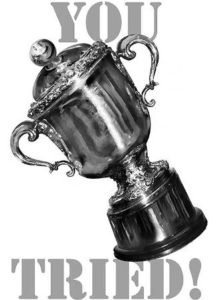 In my previous blog, I noted that 56% of the organizations that participated in a survey by I4CP, a human capital research firm, reported recently or currently undergoing a major cultural change.
In my previous blog, I noted that 56% of the organizations that participated in a survey by I4CP, a human capital research firm, reported recently or currently undergoing a major cultural change.
What I didn’t mention was that less than 15% rated the change initiative as highly successful (12.2%) or very highly successful (2.5%). Nearly half rated it as somewhat successful (18%) or moderately successful (30.2%). One-third said it was too early in the process to quantify the results, while 3.8% rated their initiative as not successful at all.
Not exactly what I would call a glowing report card for cultural change. Granted, some in the “too early to tell” category may end up having a successful transformation. But of those who did provide a rating, less than one out of four checked off highly or very highly successful. When your market has been turned upside down and your business model rendered obsolete, anything less than highly successful won’t do if you’re playing to win rather than just playing not to lose.
Look at the top three reasons respondents gave for embarking on the culture change:
- New executive leadership in the organization
- Prepare for anticipated customer or market shifts
- Desire to continually re-invent (i.e. disrupt) ourselves
Considering that new leadership often takes over when companies are struggling, all three reasons point to the need for dramatic change in the way the organizations add value to their customers. Yet, if the majority of companies in the survey recognize the compelling need for substantive change, why the low success rates? The answers lie in not so much in what they did as in what they didn’t do.
Clarity, Communication, Commitment
To launch a strategic plan, you must first set the destination – what winning looks like with specificity. Then you explain why it’s necessary to go there. Next you outline how you will get there. Then you paint a picture of how everyone will benefit when you win (reach the destination).
Transforming a culture requires the same process. However, according to survey results only slightly more than half the companies engaged in these critical steps:
- Clear communication about why the cultural change was necessary: 51.4%
- Clarity from senior leadership on the behavioral changes needed to drive and sustain the desired culture: 53.7%
- CEO committed to providing the time and resources for a successful transformation: 52.8%
Yet, as important as these steps are, they only set the stage. As with a strategic plan, follow-through is just as important, if not more so. Unfortunately, the questions that measured follow-through and commitment proved even more dismal.
Senior leadership:
- Gathered data from key stakeholders on current culture: 44.0%
- Developed a change model that emphasized the values and behaviors needed: 42.7%
- Defined and agreed to clear measures of cultural change: 34.3%
- Identified the most influential employees to help champion the change: 29.6%
- Used outside consulting services to assist with the change process: 29.2%
So, more than half the companies surveyed failed to develop a model that would support the desired culture, didn’t get employees engaged, and didn’t seek help from change professionals. Perhaps most impactful, nearly two-thirds failed to establish clear measures for cultural change. If you don’t know what the destination looks like, how will you know when you get there?
Turning Failure Into Success
Transformational change requires a daily focus on making it happen. To develop the follow-through that leads to success:
Take one bite at a time.
Break your change plan into quarterly bite-size chunks by creating action steps that map interim goals along the way to reaching your destination. For the first quarter, ask:
- How much change can we realistically achieve in this timeframe?
- What resources and capabilities must be in place to support getting there? (Who will do what, by when, with what resources is a great organizing framework to use and should be incorporated into every meeting.)
- What do we need to focus on to make progress?
Set priorities.
Of all the things you do, identify which ones contribute most to achieving the interim goals. When interruptions and/or unexpected work distract your attention, ask: how important is this compared to what I need to get done? What will move us closer to winning today?
Delegate what doesn’t belong to you.
If a task or responsibility is important, take care of it. If not, delegate or defer. Removing items from your plate that others can and should be doing keeps you focused on the top priorities.
Stay focused.
Start each day by reviewing your short- and long-term change goal as well as your destination. Then organize your day around the tasks and activities that support achieving them. Throughout the day, use visual reminders to bring you back on track when interruptions pull you away.
As the rate of change continues to pick up speed, the spoils of victory will increasingly go to organizations that can quickly respond to sudden market upheavals without losing focus. The ability to successfully lead cultural change has become a real competitive advantage and an essential leadership skill.
Holly guides leaders and their organizations in achieving greater success by teaching you to leverage your brain and the brains of others.
An experienced business leader and behavioral scientist, Holly has a rare combination of extensive academic training and in-the-trenches experience working in and leading organizations. She has also worked with elite performers including the United States Navy SEALs, Top Gun Fighter Pilots, Olympic athletes, senior NFL referees, the FBI Leadership Academy, and two United States Presidents. Holly is the former president of The Ken Blanchard Company, and co-founder of a biotech firm. She has worked in senior leadership roles with global giants including The Coca Cola Company, Dell Computer, Deloitte, and Bass Hotels and Resorts.
Holly holds a Bachelor’s degree in behavioral sciences and a Master of Science degree in organization development. Her postgraduate studies are in neurophysiology. She is a best-selling author of numerous books including More Than a Minute: How to be an Effective Leader & Manager in Today’s Changing World and Using Your Brain to Win.






